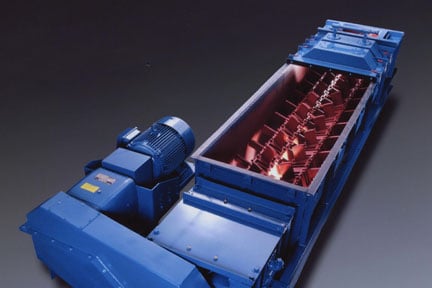When it comes to mixing bulk solids, few industrial mixers can compete with the double-shaft pugmill mixer. Often chosen for its ability to create a homogeneous mixture from both wet and dry ingredients, the pugmill mixer offers a versatile solution capable of processing everything from sludges to powders, and nearly everything in between. The high torque, combined with the kneading action imparted by the double shafts is especially ideal when it comes to heavy-duty applications.
How Does a Double-Shaft Pugmill Mixer Work?
While a single shaft pugmill mixer is occasionally suitable for light-duty mixing applications, this type of industrial mixer falls short in situations where even distribution of ingredients is required, particularly when it comes to the addition of liquids. The design of a double-shaft pugmill mixer, however, is able to create an intimate mixture of materials, even when feedstock consists of both wet and dry ingredients. Here’s how it works:
Two shafts, affixed with pitched paddles, span the length of a U-shaped trough, and move in a counter-rotating motion at a constant speed. This counter-rotating motion “lifts” material up through the center, and then pulls it back down the sides, creating a kneading and folding-over motion conducive to thorough mixing. When binders or liquid additives are required, a spray system is mounted to the interior of the mixer.
Agglomeration, or the formation of granules, is achieved through a combination of factors: the addition of water (or binder) to the material while suspended, as well as the kneading that occurs between paddles, and the “pulling” motion that occurs along trough walls. As the paddles pass by each other in the center, additional mixing occurs. To accommodate liquid additives, FEECO pugmill mixers often feature a unique raised top cover, allowing for a wider spray curtain, increased distribution of liquid, and enhanced dust suppression capabilities.
Common Pugmill Mixer Applications
Because of their flexibility, pugmill mixers lend themselves to a wide variety of applications in mixing, agglomeration, and conditioning operations.
Mixing
Pugmill mixers are frequently used as an industrial mixing solution. In a mixing setup, the mixer can be used as a stand-alone unit, or as part of a larger system. Pugmill mixers provide thorough mixing for both end products and raw feedstock materials. Materials that are commonly mixed in a pugmill mixer include:
- FGD Scrubber Sludge
- Municipal Sludge
- Fly Ash
Conditioning
When working with a dusty material, it is often desirable to de-dust the material, making it easier to handle and work with, as well as decreasing the amount of material lost as dust. This process is often referred to as conditioning and may serve to prepare a material for landfill, or for use in subsequent processing, or even for use as a final product. In a conditioning setup, pugmill mixers are frequently used as a stand-alone device, but can also serve as the front end to a larger agglomeration process. Materials that are commonly conditioned with a pugmill mixer include, but are not limited to:
- Fly Ash
- Foundry Dust
- Metal Ore Dust
- Cement or Lime Kiln Dust
Agglomeration
Pugmill mixers are also commonly used to perform agglomeration, either as a stand-alone agglomeration device, or as the precursor to a larger agglomeration setup. In this process, raw material feedstock is mixed with a liquid binder, and the kneading motion serves to begin forming pellets. These pellets can either go on to the secondary agglomeration device for further growth and refinement, or to a dryer to cure and polish them into a final product. This is commonly seen with:
- Agricultural Chemicals
- Fertilizers
- Pesticides
- Chemical Products
- Flue Dust
- Manures and Bio waste
Why A FEECO Pugmill Mixer?
FEECO pugmill mixers are constructed of heavy-duty materials, for years of reliable operation, despite intensive operating conditions. Unlike standard mixers, FEECO pugmill mixers are custom-engineered to suit the exact material and processing needs of the project at hand. This presents innumerable benefits:
- Increased efficiency
- Accommodation of unique feed materials and feedstock combinations
- Enhanced processing when incorporated into a larger process
- Improved end product characteristics
FEECO also offers a variety of additional customizations to enhance pugmill mixer performance as well:
- Various options in paddle facings to help prevent paddle wear, including cast Ni-hard facings, ceramics, and other high-end choices.
- Bottom doors to allow for undesirable materials or mixes to be dropped out of the process prior to subsequent processing.
- Various materials of construction to suit unique material processing needs.
- Special paddle designs to help improve mixing and effect retention time.
Pugmill Mixer Feasibility Testing
For those unsure of whether or not a pugmill mixer will meet their process and material objectives, FEECO offers feasibility testing in our Innovation Center.
The Innovation Center can run tests to determine agglomeration feasibility, as well as the best equipment configuration and process set-up to carry out the job. This includes testing various binders, process configurations, and other variables. Rental pugmill mixers are also available for internal test work.
FEECO pugmill mixers are backed by over 70 years of experience in testing and designing systems for a wide variety of materials. Custom designed and built for longevity, they have developed a well-earned reputation for reliability. For more information on how a pugmill mixer could benefit your material, contact us today!



